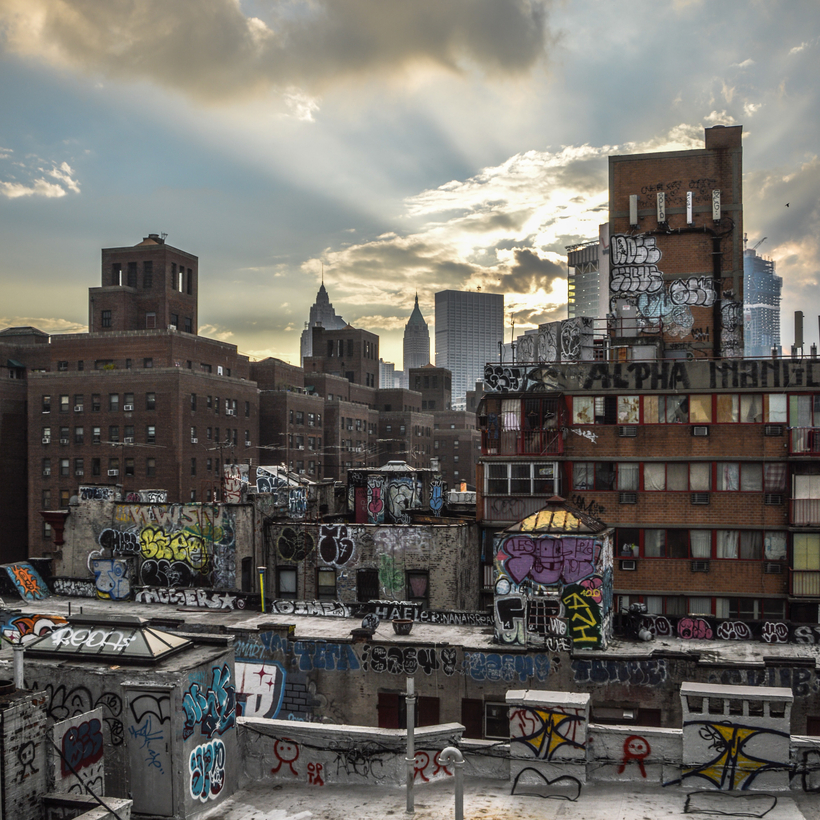Moving to New York City means setting up shop in a physical and very real place, but also in the New York City of photographs, films, and books. Even while the physical city asserts itself, the transcendental city never really goes away. You catch glimpses of it, and, if lightning strikes, you even participate in it. This is why I became a playwright.
For the better part of eight years, my life in the city has resembled Wallace Shawn’s in My Dinner with Andre, teaching high-school students by day, producing plays in unusual spaces—apartments, churches, libraries, parks, warehouses—by night. I’ve put on small, Off Broadway plays out of necessity (obscurity), and, in many ways, my life has become bound up in my little homemade-theater friendships and ideas.
Antonin Artaud wrote that theater and life are doubles of each other, like characters in a detective novel, one always shadowing the other. Life and art chase each other, never really catching up. During the pandemic, the closed loop of life and art, at least, seemed to break apart, just like the city did.

My last show was on March 9, 2020. Quarantine life, I would soon discover, was the antithesis not only of real life but of the life of the theater. The ordinary yet sacred communal space was lost, and all that remained were the questions of whether it would ever return and to what degree.
I hated it, but I didn’t want to lie fallow.
After about six months of re-evaluation and re-writing, I started to organize rehearsals, at first in parks, putting on a short play set around a park blanket in Fort Greene, later in a backyard in Bushwick (in the middle of winter, in the snow), and, eventually, with a certain amount of apprehension, indoors. And slowly—as people began to feel safe (enough) again—the tangible elements of the communal started to reappear.
Between June and October, I, along with a group of talented actors and designers, staged a total of 20 shows, split between two of my plays, in lofts in Brooklyn and Manhattan, funding them with pre-sales. Almost all the shows, albeit in very small venues with limited capacities and word-of-mouth P.R., sold out. Strangers offered us space, and, miraculously, none of our cast ever tested positive for the virus. The loop between life and art had been repaired.
For the better part of eight years, my life in the city has resembled Wallace Shawn’s in My Dinner with Andre.
At the same time we started staging loft plays, I started to hang out in Dimes Square, in Manhattan’s Chinatown. There was no rationale other than that I had a newly acquired friend with enough money to afford a large apartment on Eldridge Street, taste to furnish it, and fashionable friends to populate it.
After a relatively isolated and, frankly, depressing winter, I was surprised at how convivial the mood was. It wasn’t just my friend’s place—the whole neighborhood felt like a single, decentralized club. These were the days before Ben Smith devoted a New York Times column to the pandemic-era street newspaper The Drunken Canal, run by two Dimes Square girls, and before Ella Emhoff became the unofficial Dimes mascot. You felt like you were in on a secret.

The previous summer, I had dated a writer who lived near Dimes Square, and she seemed to think this was very cool, but I was skeptical. If you wanted to be cool, she said, you had to hang out there. I hated the idea, but she was right—the neighborhood was irreverent and fun, and it was hard not to get sucked in. So I did.
These were the days before Ben Smith devoted a New York Times column to The Drunken Canal. You felt like you were in on a secret.
Many definitions have already been attempted, but Dimes Square runs along Canal Street roughly from Essex Street to Allen Street. (It’s not a square, by the way—it’s a feeling.) It’s named after a restaurant called Dimes, where a lot of very hip people go to see and be seen.
Dimes Square people go to movies at Metrograph (Film Forum is for Gen Xers); they also hang out at Kiki’s (a Greek restaurant whose exterior is covered in Chinese writing) and Clandestino (a bar down the street, and the beating heart of the scene). Fashion is largely an homage to Kids. Cigarettes are cool, obviously. During the day, you can write at the coffee shop Little Canal (but don’t bring a laptop). You will see people reading The Drunken Canal both ironically and unironically.
Dimes Square is self-referential—it created itself, mostly self-awarely, and seems to have gone through the life cycle of earlier cool decades, such as the 70s, 80s, and 90s, in just a year or two. It’s a kind of millennial-Zoomer co-production of the pre-Bloomberg years, featuring Gen X barflies as special guests. The Dimes Square stereotype is rich and hot. The reality is heroin not-quite-chic.

In short, Dimes Square was a fictional universe before anyone decided to fictionalize it, and it will inevitably go on to be the subject and locus of TV series and indie movies. That is, in fact, what it always wanted to be, and that’s what it’s becoming.
I wrote a play about it, which premieres tomorrow. I can only hope that I’m not too late (or too early).
Dimes Square is the “double” my cast and I are chasing—the shadow that might turn out to be the real thing.
Matthew Gasda is a teacher and playwright living in New York. His latest play, Dimes Square, premieres tomorrow at Ty’s Loft, in Brooklyn, and will show at various locations throughout the city this spring
